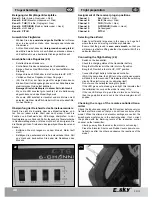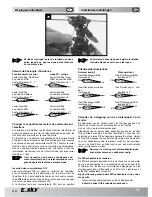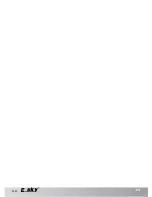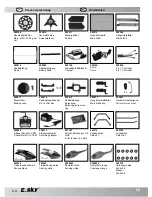
05/10
54
Wartung / Entsorgung
Maintenance / disposal
Wartung
Eine regelmäßige Inspektion und Wartung der
Komponenten des Helikopters und der Basi-
seinstellungen ist notwendig für einen sicheren
Betrieb und optimale Leistungsfähigkeit.
Prüfen Sie generell
Alle Schraubverbindungen. Sichern Sie ggf. mit Schrauben-
sicherungslack.
Den sicheren Sitz des Flugakkus
Die Balance des Modells
Rumpf/Chassis
Das
Hauptrotorwellenlager
muss spätestens alle 100 Flü-
ge ausgetauscht werden. Bei häufigem 3D-Flug sogar alle
50 Flüge. Führen Sie ein Flugbuch, um die Wartungsinter-
valle im Auge zu behalten.
Kugellagerhülsen/Gleitlagerhülsen müssen alle 50 Flüge ge-
schmiert werden. Wenn das Hauptwellenzahnrad Spiel hat,
muss das Gleitlager ausgetauscht werden.
Hauptrotor
Überprüfen Sie die Hauptrotorblätter auf Beschädigungen.
Beschädigte Rotorblätter führen zu Unwucht und schlimms-
tenfalls zu einem Kontrollverlust.
Stellen Sie sicher, dass die Rotorblätter ausgewuchtet sind.
Prüfen Sie den Spurlauf.
Kontrollieren Sie auch die Halteschrauben an den Rotorblät-
tern. Diese dürfen nur so fest angezogen werden, dass die
Rotorblätter noch in der Lage sind, sich während des Be-
triebs im 180°- Winkel zueinander auszurichten. Nur so ist
ein vibrationsarmer Lauf ohne Unwucht möglich.
Wenn Sie die Rotorwelle waagerecht halten, müssen die Ro-
torblätter von selbst nach unten abklappen.
Achten Sie auf die Hauptrotorwelle; ist die Rotorwelle verbo-
gen, führt dies zu Unwucht und ggf. zu Kontrollverlust.
Prüfen Sie die O-Ringe; Verschleiss und UV-Strahlung ver-
ringern die Elastizität der O-Ringe, was erhöhtes Spiel der
Rotorwelle zur Folge hat.
Kontrollieren Sie die Führung der
Taumelscheibe
auf der
Rotorwelle; die Kugel muss sich leichtgängig auf der Welle
verschieben lassen, die Kugelpfanne darf nicht ausgeschla-
gen sein.
Die Anlenkungen und Umlenkungen der Taumelschei-
bensteuerung müssen müssen leichtgängig und verspan-
nungsfrei arbeiten.
Achten Sie auf gleiche Länge der
Paddelstangen
(Abstand
Steuerpaddel/ Befestigung der Paddelstange)
Ruderhörner, Kugelköpfe, Anlenkungen
Achten Sie auf Spiel, Leichtgängigkeit und Beschädigungen.
Sämtliche Anlenkungen müssen gradlinig und verspan-
nungsfrei verlaufen.
Heckrotor
Überprüfen Sie die
Heckrotorblätter
auf Beschädigungen.
Defekte Rotorblätter führen zu Unwucht und Vibrationen.
Schon leichte Bodenberührung kann die Blätter beschädi-
gen.
Vermeiden Sie Starts und Landungen in hohem Gras, da
sich dieses im Heckrotorsystem verfangen und es beschä-
digen kann.
-
-
-
-
-
-
-
-
-
-
-
-
-
-
-
-
-
-
Maintenance
A regular inspection and maintenance of the
components of the helicopter as well as the
basic settings is essential for a safe operation
and optimum performance.
Check
all bolted connections. If required, secure them with the
screw locking paint.
if the flight battery is in place
the model balance
Fuselage / chassis
Change the main rotor shaft bearing at least after every 100
flights. If you frequently undertake 3D flights, change this
shaft after every 50 flights. Maintain a flight log so that the
maintenance intervals are followed.
Lubricate the ball bearing sockets / sliding bearing sockets
after every 50 flights. If the main shaft pinion has a play, re-
place the sliding bearing.
Main rotor
Check the main rotor blades for damages. Damaged rotor
blades could lead to misalignment and loss of control.
Ensure the correct alignment of the rotor blades.
Check the pitch.
Also check the retaining screws on the rotor blades. These
should not be tightened too firmly, so as to allow the rotor
blades to align at an angle of 180° to one another during the
operation. A low-vibration running without misalignment can
be guaranteed only in this manner.
If you hold the rotor shaft horizontally, the rotor blades must
be able to fold downwards.
Pay attention to the main rotor shaft; if it is bent, this will lead
to misalignment and thereby loss of control.
Check the O-rings; these rings lose their elasticity due to
wear and UV radiation, which in turn increases the play of
the rotor shaft.
Check the alignment of the swash plate on the rotor shaft;
the ball must move smoothly on the shaft and there should
be no deflection of the ball socket.
The steering and deflecting mechanisms of the swash plate
control system must move smoothly and without any distor-
tion.
Ensure that length of the paddle rods (distance between
the control paddle and attachment of the paddle rod) is the
same
Rudder horns, ball ends, steering mechanisms
Check for any play and damages. Ensure smooth move-
ment. All the steering mechanisms must be in a straight line
and free from distortion.
Tail rotor
Check the
tail rotor blades
for damages. Defective rotor
blades lead to misalignment and vibrations. Even a slight
contact with the ground damages the blades.
Avoiding taking off and landing the helicopter on grass, since
it might get caught in the tail rotor system and damage the
same.
Dismantle the tail rotor housing after every 50 flights for in-
spection and maintenance.
-
-
-
-
-
-
-
-
-
-
-
-
-
-
-
-
-
-
-
















































